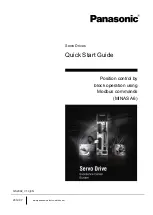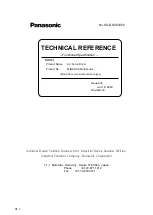
D
D
C
C
S
S
8
8
1
1
0
0
D
D
i
i
g
g
i
i
t
t
a
a
l
l
D
D
C
C
S
S
e
e
r
r
v
v
o
o
D
D
r
r
i
i
v
v
e
e
r
r
M
M
a
a
n
n
u
u
a
a
l
l
R
R
e
e
v
v
1
1
.
.
0
0
Tel: (86)755-26434369
5
Website: www.leadshine.com
Power Connector
Pin
Signal
Description
I/O
1
Motor+
Motor positive connection.
O
2
Motor-
Motor negative connection.
O
3
+VDC
+18 TO 80VDC power input.
I
4
GND
Power ground.
GND
RS232 Communication Connector
Pin
Signal
Description
I/O
1
NC
Not connected.
-
2
+5V
+5V power only for STU.
O
3
TxD
RS232 transmit.
O
4
GND
Ground.
GND
5
RxD
RS232 receive.
I
6
NC
Not connected.
-
More about PUL/DIR/EN Signals
Pin Function
Details
PUL+
PUL-
Pulse signal: In single pulse (pulse/direction) mode, this input represents
pulse signal; 4-5V when PUL-HIGH, 0-0.5V when PUL-LOW. In double
pulse mode (pulse/pulse) , this input represents clockwise (CW) pulse
,
effective at LOW level (the fixed level). For reliable response, pulse width
should be longer than 1.0
μ
s. Series connect resistors for current-limiting
when using +12V or +24V control signals.
DIR+
DIR-
DIR signal: In single-pulse mode, this signal has low/high voltage levels,
representing two directions of motor rotation(set by inside R33 and R37); in
double-pulse mode, this signal is counter-clock (CCW) pulse
,
effective at
LOW level (the fixed level). For reliable motion response, DIR signal should
be ahead of PUL signal by 5
μ
s at least. 4-5V when DIR-HIGH, 0-0.5V when
DIR-LOW. Please note that motion direction is also related to motor-driver
wiring and encoder feedback A/B phase signals. Exchanging the connections
of two wires of the motor to the driver and A/B phase signals of encoder will
reverse motion direction.
EN+
EN-
Enable signal: This signal is used for enabling/disabling the driver. High
level (NPN control signal, PNP and Differential control signals are on the
contrary, namely Low level for enabling.) for enabling the driver and low
level for disabling the driver. Usually left
UNCONNECTED (ENABLED)
.
Series connect resistors for current-limiting when using +12V or +24V
control signals.
D
D
C
C
S
S
8
8
1
1
0
0
D
D
i
i
g
g
i
i
t
t
a
a
l
l
D
D
C
C
S
S
e
e
r
r
v
v
o
o
D
D
r
r
i
i
v
v
e
e
r
r
M
M
a
a
n
n
u
u
a
a
l
l
R
R
e
e
v
v
1
1
.
.
0
0
Tel: (86)755-26434369
6
Website: www.leadshine.com
PUL/DIR and CW/CCW Mode Settings
There are four resistors (R31/R32/R33/R37) inside the DCS810 specifically for
setting PUL/DIR and CW/CCW modes, as shown in figure 2. Default setting is (b),
namely PUL/DIR mode, DIR LOW for positive direction and DIR HIGH for
negative direction.
(a) R31, R37 short circuit, PUL/DIR mode (b) R31, R37 short circuit, PUL/DIR mode
DIR HIGH for Positive Direction DIR LOW for Positive Direction
DIR LOW for Negative Direction DIR HIGH for Negative Direction
(c) R32, R37 short circuit, CW/CCW mode
effective at LOW level (The fixed level)
Figure 2: PUL/DIR and CW/CCW settings
Control Signal Connections
The DCS810 can accept differential and single-ended inputs (including
open-collector and PNP output). The DCS810 has 2 optically isolated logic inputs to
accept line driver control signals. These inputs are isolated to minimize or eliminate
electrical noises coupled onto the control signals. Recommend use line driver
control signals to increase noise immunity in interference environments. In the
following figures, connections to open-collector and differential control signals are
illustrated.































